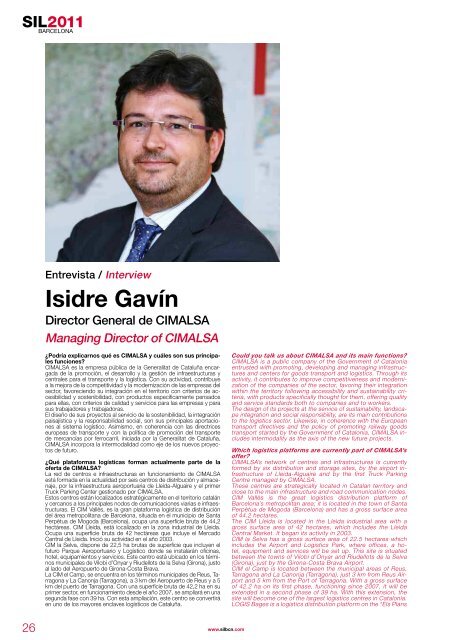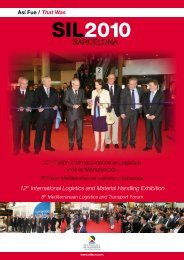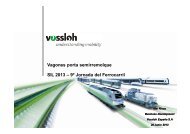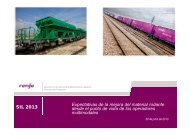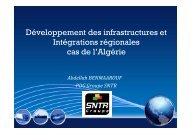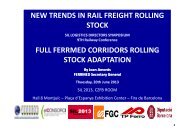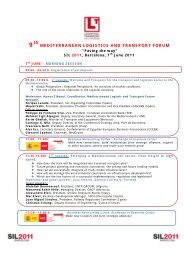descargar resumen sil 2011
descargar resumen sil 2011
descargar resumen sil 2011
You also want an ePaper? Increase the reach of your titles
YUMPU automatically turns print PDFs into web optimized ePapers that Google loves.
Entrevista / Interview<br />
Isidre Gavín<br />
Director General de CIMALSA<br />
Managing Director of CIMALSA<br />
¿Podría explicarnos qué es CIMALSA y cuáles son sus principales<br />
funciones?<br />
CIMALSA es la empresa pública de la Generalitat de Cataluña encargada<br />
de la promoción, el desarrollo y la gestión de infraestructuras y<br />
centrales para el transporte y la logística. Con su actividad, contribuye<br />
a la mejora de la competitividad y la modernización de las empresas del<br />
sector, favoreciendo su integración en el territorio con criterios de accesibilidad<br />
y sostenibilidad, con productos específicamente pensados<br />
para ellas, con criterios de calidad y servicios para las empresas y para<br />
sus trabajadores y trabajadoras.<br />
El diseño de sus proyectos al servicio de la sostenibilidad, la integración<br />
paisajística y la responsabilidad social, son sus principales aportaciones<br />
al sistema logístico. Asimismo, en coherencia con las directrices<br />
europeas de transporte y con la política de promoción del transporte<br />
de mercancías por ferrocarril, iniciada por la Generalitat de Cataluña,<br />
CIMALSA incorpora la intermodalidad como eje de los nuevos proyectos<br />
de futuro.<br />
¿Qué plataformas logísticas forman actualmente parte de la<br />
oferta de CIMALSA?<br />
La red de centros e infraestructuras en funcionamiento de CIMALSA<br />
está formada en la actualidad por seis centros de distribución y almacenaje,<br />
por la infraestructura aeroportuaria de Lleida-Alguaire y el primer<br />
Truck Parking Center gestionado por CIMALSA.<br />
Estos centros están localizados estratégicamente en el territorio catalán<br />
y cercanos a los principales nodos de comunicaciones viarias e infraestructuras.<br />
El CIM Vallès, es la gran plataforma logística de distribución<br />
del área metropolitana de Barcelona, situada en el municipio de Santa<br />
Perpètua de Mogoda (Barcelona), ocupa una superficie bruta de 44,2<br />
hectáreas. CIM Lleida, está localizado en la zona industrial de Lleida.<br />
Ocupa una superficie bruta de 42 hectáreas que incluye el Mercado<br />
Central de Lleida. Inició su actividad en el año 2003.<br />
CIM la Selva, dispone de 22,5 ha brutas de superficie que incluyen el<br />
futuro Parque Aeroportuario y Logístico donde se instalarán oficinas,<br />
hotel, equipamientos y servicios. Este centro está ubicado en los términos<br />
municipales de Vilobí d’Onyar y Riudellots de la Selva (Girona), justo<br />
al lado del Aeropuerto de Girona-Costa Brava.<br />
La CIM el Camp, se encuentra en los términos municipales de Reus, Tarragona<br />
y La Canonja (Tarragona), a 3 km del Aeropuerto de Reus y a 5<br />
km del puerto de Tarragona. Con una superficie bruta de 42,2 ha en su<br />
primer sector, en funcionamiento desde el año 2007, se ampliará en una<br />
segunda fase con 39 ha. Con esta ampliación, este centro se convertirá<br />
en uno de los mayores enclaves logísticos de Cataluña.<br />
Could you talk us about CIMALSA and its main functions?<br />
CIMALSA is a public company of the Government of Catalonia<br />
entrusted with promoting, developing and managing infrastructures<br />
and centers for goods transport and logistics. Through its<br />
activity, it contributes to improve competitiveness and modernization<br />
of the companies of the sector, favoring their integration<br />
within the territory following accessibility and sustainability criteria,<br />
with products specifically thought for them, offering quality<br />
and service standards both to companies and to workers.<br />
The design of its projects at the service of sustainability, landscape<br />
integration and social responsibility, are its main contributions<br />
to the logistics sector. Likewise, in coherence with the European<br />
transport directives and the policy of promoting railway goods<br />
transport started by the Government of Catalonia, CIMALSA includes<br />
intermodality as the axis of the new future projects.<br />
Which logistics platforms are currently part of CIMALSA’s<br />
offer?<br />
CIMALSA’s network of centres and infrastructures is currently<br />
formed by six distribution and storage sites, by the airport infrastructure<br />
of Lleida-Alguaire and by the first Truck Parking<br />
Centre managed by CIMALSA.<br />
These centres are strategically located in Catalan territory and<br />
close to the main infrastructure and road communication nodes.<br />
CIM Vallès is the great logistics distribution platform of<br />
Barcelona’s metropolitan area; it is located in the town of Santa<br />
Perpètua de Mogoda (Barcelona) and has a gross surface area<br />
of 44.2 hectares.<br />
The CIM Lleida is located in the Lleida industrial area with a<br />
gross surface area of 42 hectares, which includes the Lleida<br />
Central Market. It began its activity in 2003.<br />
CIM la Selva has a gross surface area of 22.5 hectares which<br />
includes the Airport and Logistics Park, where offices, a hotel,<br />
equipment and services will be set up. This site is situated<br />
between the towns of Vilobí d’Onyar and Riudellots de la Selva<br />
(Girona), just by the Girona-Costa Brava Airport.<br />
CIM el Camp is located between the municipal areas of Reus,<br />
Tarragona and La Canonja (Tarragona), just 3 km from Reus Airport<br />
and 5 km from the Port of Tarragona. With a gross surface<br />
of 42.2 ha on its first phase, functioning since 2007, it will be<br />
extended in a second phase of 39 ha. With this extension, the<br />
site will become one of the largest logistics centres in Catalonia.<br />
LOGIS Bages is a logistics distribution platform on the “Els Plans<br />
LOGIS Bages, es una plataforma logística de distribución, situada en el<br />
polígono “Els Plans de la Sala” en el término municipal de Sallent (Barcelona).<br />
En una superficie de 8,7 ha, dispone de una nave modulada<br />
de 53.000 m 2 . LOGIS Empordà, es un centro para logística y distribución<br />
y actividades de valor añadido con vocación transfronteriza. Está<br />
localizado en el municipio de El Far d’Empordà (Girona). Tiene una superficie<br />
bruta de 72 ha, de las cuales está urbanizada una primera fase<br />
de 21 ha. CIMALSA también gestiona el Truck Parking Centre ubicado<br />
en el término de Castellar del Vallès. Con una superficie rectangular de<br />
15.400 m 2 , dispone en total de 126 plazas para el estacionamiento de<br />
vehículos de gran tonelaje de hasta 17 metros de longitud. Este centro,<br />
totalmente cerrado, dispone de control de accesos y salidas y está<br />
dotado de sistemas avanzados de control de vigilancia y protección<br />
24x7x365.<br />
¿El ferrocarril es una apuesta prioritaria de CIMALSA?<br />
La apuesta prioritaria de CIMALSA es la intermodalidad, que consideramos<br />
el único camino para conseguir una logística sostenible y eficiente,<br />
dotando al conjunto de la actividad económica del país de una mayor<br />
competitividad especialmente en el sector industrial donde los costes<br />
logísticos son considerables en relación con el conjunto de costes de<br />
la actividad.<br />
Esta apuesta por la intermodalidad la hacemos sabiendo que la distribución<br />
de mercancías por carretera seguirá siendo mayoritaria en los<br />
próximos años, que el transporte ferroviario tiene tasas casi marginales<br />
en el mercado (4%), con infraestructuras obsoletas y en plataformas<br />
que cierran la cadena.<br />
Pero es urgente posicionarse ahora y prever una red intermodal importante,<br />
con infraestructuras modernas y pensando en el futuro. El modo<br />
marítimo muestra una fuerza considerable y pensamos que seguirá<br />
siendo así en el futuro, y que el ro-ro y la autopista ferroviaria todavía<br />
ganarán terreno.<br />
¿Cuáles son los planes de futuro más inmediato de CIMALSA?<br />
El desarrollo de las plataformas intermodales que estamos promoviendo<br />
en este momento (Empordà, Penedés y Montblanc), dada la importancia<br />
de dotar al sector de plataformas intermodales. Todas ellas están<br />
integradas en el eje Mediterráneo de mercancías por ferrocarril que promueve<br />
Ferrmed y que creemos que es un corredor muy necesario para<br />
toda Europa, no hay que olvidar que dos de ellas fueron declaradas<br />
como prioritarias por el gobierno central.<br />
También trabajamos en la ampliación del CIM el Camp de Tarragona, en<br />
la promoción de la carga aérea, en la intensificación de la colaboración<br />
público-privada, en la internacionalización de nuestra actividad y en el<br />
perfeccionamiento de nuestro Observatorio Logístico como herramienta<br />
para mejorar la eficiencia de nuestro sistema logístico.<br />
¿Qué papel juega Catalunya dentro del panorama logístico Mundial?<br />
Estamos convencidos de que juega un papel importante pero que será<br />
todavía más si se construyen las infraestructuras que faltan.<br />
El hecho de que la mayor parte de mercancías por vía marítima del<br />
mundo circulen por el Mediterráneo entre Asia y Europa nos debe permitir<br />
captar una buena parte de esta carga que hoy pasa con destino<br />
a los puertos del norte de Europa y que amarrando en los puertos de<br />
nuestra fachada Mediterránea (Barcelona y Tarragona, pero también<br />
Valencia o Castellón) se ahorrarían entre 3 y 4 días de navegación, tiempo<br />
y emisiones de CO 2 .<br />
A pesar de que los puertos están ejecutando importantes proyectos de<br />
ampliación, si no se les dota de buenas conexiones viarias y ferroviarias<br />
no conseguiremos en tierra la gran capacidad que pueden conseguir<br />
nuestros puertos; aun así creemos que con nuestras infraestructuras<br />
actuales y futuras Cataluña y el conjunto de la fachada Mediterránea están<br />
llamados a crecer hasta ser una de las más importantes puertas de<br />
entrada de mercancías del mundo al continente Europeo y, por tanto,<br />
una de las mayores plataformas logísticas del continente.<br />
¿Y dentro del territorio español?<br />
Pienso que en cierto sentido Cataluña ha sido pionera en el desarrollo<br />
logístico en España y creo que puede seguir siendo un territorio estratégico<br />
para la actividad logística por su posición geográfica: cruce de<br />
rutas del valle del Ebro con la ruta mediterránea, por sus infraestructuras<br />
portuarias, por su red de plataformas logísticas y por su tradición<br />
industrial.<br />
¿Es importante para Cataluña disponer de una feria logística de<br />
la envergadura del SIL?<br />
Es muy importante y se ha vuelto a demostrar este año, no sólo por la<br />
actividad comercial que, en general, ya no se concentra tanto en las<br />
actividades presenciales sino además como punto de encuentro profesional,<br />
foro de debate y de intercambio de experiencias.<br />
El SIL además ha conseguido ser realmente un foro mediterráneo de<br />
la logística y ésto debe ser una apuesta estratégica para toda Europa<br />
en relación con los países del Magreb y de África en general que están<br />
creciendo y desarrollando sus economías.<br />
¿Qué valoración hacen de su participación en el SIL <strong>2011</strong>?<br />
Muy positiva. A pesar de desarrollarse en un momento de poca actividad<br />
y de grandes dificultades para el crecimiento económico, la participación<br />
ha sido muy interesante en todos los frentes: institucional con<br />
la firma del Protocolo para el desarrollo de las plataformas intermodales<br />
estratégicas en Cataluña entre el gobierno español y el catalán, en lo<br />
económico por los contactos, y en lo profesional por las excelentes<br />
jornadas técnicas.<br />
de la Sala” industrial park in the municipal area of Sallent (Barcelona).<br />
On a surface area of 8.7 ha there is a modulated warehouse<br />
of 53,000 sqm. LOGIS Empordà is a centre for logistics<br />
and distribution and value-added activities with a cross-border<br />
vocation. It is located in the municipality of el Far d’Empordà<br />
(Girona). It has a gross surface area of 73 ha of which the first<br />
phase of 22 hectares has already been urbanised. CIMALSA<br />
also manages the Truck Parking Centre, which is located in the<br />
municipality of Castellar del Vallès. With a rectangular surface of<br />
15,400 sqm, it has a total of 126 parking lots for heavy goods<br />
vehicles up to 17 metres long. This site, totally closed, has access<br />
and exit controls and it is equipped with 24x7x365 monitoring<br />
and protection systems.<br />
Is the railway a priority bet for CIMALSA?<br />
The priority bet of CIMALSA is intermodality, since we see it as<br />
the only way to get a sustainable and efficient logistics, providing<br />
the rest of the economic activity of the country with greater<br />
competitiveness, particularly on the industrial sector where logistical<br />
costs are higher in relation with the overall activity costs.<br />
We make this bet for intermodality aware that road freight transport<br />
will keep on being the most used over the next years and<br />
that railway transport has lower marginal rates (4%), with obsolete<br />
infrastructures and in platforms which close the chain.<br />
But it is urgent to set positions now and to plan an important<br />
intermodal network, with modern infrastructures and thought for<br />
the future. Maritime mode shows a considerable strength and<br />
everything points it will continue this way in the future. RoRo and<br />
rail-highway will, however, gain ground.<br />
Which are the most immediate future plans of CIMALSA?<br />
The development of the intermodal platforms that we are currently<br />
promoting (Empordà, Penedés and Montblanc), seen the<br />
importance of providing the sector with this kind of platforms.<br />
All of them are integrated in the Mediterranean rail freight axis<br />
promoted by Ferrmed, a corridor which we consider very important<br />
for Europe, and we should not forget that two of them were<br />
declared as a priority by the central government.<br />
We also work in the extension of CIM el Camp in Tarragona,<br />
in the promotion of air freight, in the enhancement of publicprivate<br />
partnership, in the internationalization of our activity and<br />
in the implementation of our Logistics Observatory as a tool for<br />
improving the efficiency of our logistics system.<br />
Which role does Catalonia play within the world logistics<br />
scene?<br />
We are convinced that it plays an important role but it shall be<br />
even more if the missing infrastructures are built.<br />
The fact of having the majority of goods by maritime transport circulating<br />
on the Mediterranean between Asia and Europe, should<br />
make us gain part of this freight going to the northern Europe<br />
ports and, furthermore, by mooring at our Mediterranean façade<br />
(Barcelona and Tarragona, but also Valencia or Castellón) there<br />
would make them save between 3 and 4 navigation days, time<br />
and CO2 emissions.<br />
Although ports are executing important extension projects, if<br />
they are not provided with good road and rail connections, we<br />
will not achieve in land the great capacity that our ports can<br />
reach. However, we are sure that with the current and future<br />
infrastructures, Catalonia and the Mediterranean façade are set<br />
to become one of the main good entrance doors from the world<br />
to the European continent and, therefore, one of the biggest<br />
logistics platforms of the said continent.<br />
And within the Spanish territory?<br />
I think that in a sense Catalonia has been pioneer in the Spanish<br />
logistics development and that it can remain being a strategic<br />
spot for the logistics activity thanks to its geographical location:<br />
a crossing between the Ebro valley and the Mediterranean routes,<br />
its port infrastructures, its logistics platforms network and<br />
its industrial tradition.<br />
Is it important for Catalonia to have a logistics exhibition<br />
of the size of SIL?<br />
It is very important and it has indeed been showed again this<br />
year, not only for the sales activity which, in general, is no longer<br />
focused only on face-to-face activities, but also as a professional<br />
meeting point, a debate and experiences exchange forum.<br />
Furthermore SIL has got to be a proper logistics Mediterranean<br />
forum and this must be a strategic bet for all Europe in relation<br />
with the Maghreb and African countries in general, which are<br />
growing and developing their economies.<br />
What is the assessment of your participation in SIL <strong>2011</strong>?<br />
Very positive. In spite of taking place in a moment of low activity<br />
and great constraints for the economic growth, the participation<br />
has been very interesting in all fields: institutional, with the signature<br />
of the Protocol for the development of the strategic intermodal<br />
platforms for Catalonia signed between the Catalan and<br />
Spanish governments; in the economic field, for the contacts<br />
made, and in the professional one, for the excellent technical<br />
conferences.<br />
26 27


